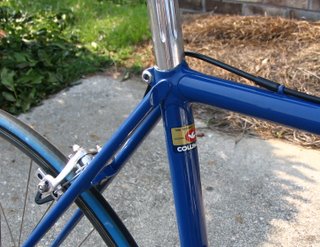Brazing vs. Welding
 Tue, October 3, 2006
Tue, October 3, 2006 
I occasionally visit bike forums to see what kind of questions bike riders are asking and occasionally I will post a reply if I think I have an answer. I try to stay away from anything controversial as people can become pretty hostile on the Internet; especially when they are posting under a pseudonym.
Just like the idiot who screams abuse at the cyclist as they drive by at speed; they do it because they can do so with anonymity. So does the occasional poster on a forum; he screams abuse on the Information Highway.
Recently someone asked, “Why are frames brazed instead of welded?” He had taken a welding course at his local community college and the teacher had told him that welding was much stronger than brazing. This was my response:
“Traditionally frames have always been brazed not because a weld would fail but because the tube would fail right next to the weld due to the tube being very thin. Many bicycle tubes are heat treated to strengthen them. The trick in brazing properly is to apply enough heat to make the lugged joint but not to get the tubes too hot over a large area; thereby retaining as much of the tube's inbuilt strength as possible.
A properly brazed lugged joint is tremendously strong and a lug spreads the stresses over a larger area, not pinpointed in one place as with a weld. This is also the reason lugs are cut into curved or other fancy shapes, and not just cut square like a pipe fitting. A square edge would create a stress point and the tube would likely fail at that point.
To sum up; yes a welded joint may be stronger, but in any structure there is no point in making a joint far stronger than the material you are joining. And if the structure is stressed enough the material will fail before the joint.”
Notice I started my post with the word “Traditionally.” And actually the question was wrong because frames are welded these days. And I should have known better than to post something like this, because every propeller head engineer who knows welding theory up the wazoo would jump on it like a kid on a merry-go-round. The next thing I know the subject is being debated.
The truth is that frames were brazed for about a hundred years from the bicycle’s invention up until the late 1980s, early 1990s. About the time I got out of the business. Not just lightweight bikes but all bikes. Actually during the 1980s welding technology had reached a point were I could have welded frames that I built. But I did not because at that time it would not have been accepted by my customers; anymore than a sloping top tube would have been acceptable.
Mountain Bikes changed all that. You had a whole generation that had grown up with welded BMX bikes. BMX bikes had small frames with sloping top tubes so little Johnny would not ruin his chances of reproduction in later life. So the MTB frame began to look more and more like an adult size BMX bike with gears.
Early mountain bikes were built with lugs and had level top tubes. So the BMX bike had more influence on today’s bicycle design than the first mountain bikes. Other influences on the acceptance of welding were frames built in other materials that cannot be brazed like aluminum and titanium.
Once a new style has been accepted you cannot go back. I could not go back to running a viable business building lugged frames even if I had the desire, which I don’t. And the truth is whether a frame is brazed with lugs or welded; either is far stronger than it need be.
Footnote: If you are interested in welding as a vocation, this might be a place to start: "How to become a cetified welder."
 Dave Moulton | Comments Off |
Dave Moulton | Comments Off | 

















Reader Comments (3)
Bob Jackson,Waterford, Roberts. These will offer both lugged and welded or fillet-brazed (Thorn), but this is interesting from Rivendell:
"All of our frames are steel and lugged.
Not because lugged steel frames are delightfully charming in an old-fashioned way, but because steel is the best material for a lightweight structure that you trust your life to; and the strongest and most beautiful frame joints are lugged."
I own a couple of Woodrup frames and a Mercian, all dating from the early 80s. I expect them to last the rest of my cycling life.
Cheers
Peter.
"Traditionally frames were never welded."
Not true, there were welded bikes made in the US in the early part of the 20th century, and by one account they were a stout competitor for Schwinn.
"Not because welding was not strong enough but rather the heat required to weld weakened the parent material adjacent to the weld."
This view was held but is difficult to justify when the exact same tubes were being welded into aircraft by the hundreds of thousands. The main problems that arises in welding, either have no effect on plain steel which was common in early days; have no impact on non-heat treated chromo; or where heat treated chromo is concerned all torch work has an adverse effect, and the effect of welding can actually be less (not really any better) since the heat affected zone is generally wider with brazing since it involves heating a large area.
All methods do work when properly used.
Thomas.
Thanks for the great post. I really like it what i have read so far in your blog